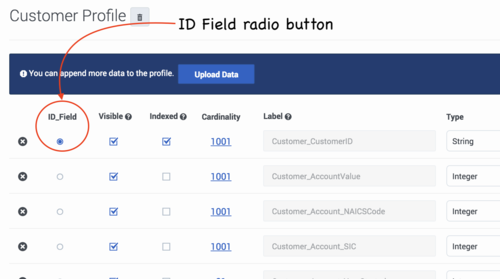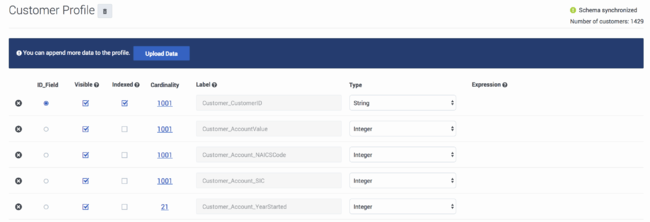Contents
Configuring Customer Profiles
Use the Customer Profile tab to import and configure customer-related data that you can then use to create Predictors. You must gather the desired data into a CSV file. Make sure the data is formatted with a consistent schema. After importing, you can append data, which enables you to make updates.
- To open the configuration menu, click the Settings gear icon, located on the right side of the top menu bar:
 .
. - See Supported Encodings and Unsupported Characters for information on how to configure your data.
Procedure: Create your Customer Profile schema
Purpose: To establish a schema where all data falls into a set structure; for example, all data within a certain column must have the same data type. GPR analyzes your data, recognizes the structure, and ensures that all data you upload later complies with the established schema.Prerequisites
- A small starter customer profile consisting of at least the customer_ID column and several rows containing placeholder values for each column that can establish the correct data type for that column.
Steps
Click the Customer Profile tab, then follow the steps to create a Customer Profile schema:
- Click Create Schema. The Create Profile Schema dialog box opens.
- Click Select file. Navigate to your small starter CSV file and select it.
- Your CSV file can be zipped. You do not need to unzip it for uploading.
- Select the separator type for your CSV file. You can choose either TAB or COMMA.
- Select the encoding type. By default, this is utf-8.
- Click Create. The uploaded data appears on the Customer Profile window.
- Set the ID Field. This field must have a unique value in each row that identifies the customer whose data appears in it.
- The data type must be String. If the data type is not set correctly when the data is uploaded, change the data type by clicking in the Type column and selecting String from the drop-down list.
- Scroll to the bottom of the window and click Save Schema. A Success. Schema updated successfully status message appears in the upper right side of the Customer Profile window.
- Click Sync Schema.
- Scroll to the top of the list of fields and click Accept Schema. A Success. Schema accepted successfully status message appears.
This procedure has:
- Established the schema structure for the required columns.
- Established the column containing the ID Field parameter.
Next Step: Upload the remainder of your data.
Procedure: Upload your Customer Profile data
Purpose: Upload your Customer Profile data to the established schema.Prerequisites
- You have created a schema, as described in the procedure above.
- You have created a CSV file containing all your Customer Profile data in the accepted schema structure.
Steps
Click the Customer Profile tab, then follow the steps to upload your data:
- Click Upload Data. The Create Profile Schema dialog box opens.
- Click Select File. Navigate to your complete CSV file and select it.
- Your CSV file can be zipped. You do not need to unzip it for uploading.
- Select the separator type for your CSV file. You can choose either TAB or COMMA.
- Click Create. The uploaded data appears on the Customer Profile window.
- Adjust any data types in the Type column that were interpreted incorrectly.
- Adjust the Visibility toggle, if desired, to hide fields you do not need to see on the Customer Details tab.
- NOTE: The Visibility toggle simply enables you to configure the display to make it easier to see the fields you are most interested in. Hidden fields continue to be processed. Visibility settings are saved automatically. You do not need to save the schema when updating visibility.
- Adjust the Index toggle to have key fields indexed. Indexing makes lookups faster for that field. The field you specify as the ID_FIELD is indexed by default.
- ImportantA Customer Profile dataset should have no more than 64 indexed fields.
- Delete any fields you do not want included by clicking the X to the left of the field name.
- Scroll to the bottom of the list of fields and click Save Schema. A Success. Schema updated successfully status message appears in the upper right side of the Schema tab.
This procedure has:
- Completed the data upload to GPR.
Next Steps:
Procedure: (Optional) Add new fields to the Customer Profile schema
Steps
- Click Add New Field.
- Add any number of discovered fields to the Customer Profile schema from the drop-down menu.
- (Optional) Type a new field name and press Enter to add a custom field. The custom field value is an expression constructed from arithmetic operations, Python 3 built-in functions, and discovered fields.
- To access the built-in functions, press the SHIFT+@ shortcut.
- Click Save Schema.
Procedure: Synchronize and accept the schema
Purpose: You must synchronize the schema before you can use it.Prerequisites
You must already have created your schema, uploaded your data, and saved the schema.
Steps
- Click Sync Schema.
- Scroll to the top of the Schema tab and click Accept Schema. A Success. Schema accepted successfully status message appears.
- When the schema has been accepted, the Schema out of synchronization message changes to Schema synchronized and the associated icon turns green.
- When data upload is completed, the Customer Profile list displays the fields discovered in your data, along with their data types and cardinality values.
The List of Customer Profile Fields
When you navigate to the Settings > Customer Profile page, and you have imported a Customer Profile schema, your data is displayed in a table. Each row presents a schema column.
- The columns in the Customer Profile list are the following:
- ID Field - The field containing the employeeID value.
- Visible - Show which fields are visible on the Customer Details tab.
- Indexed - Shows which fields are indexed, which makes lookups faster for that field. The field you specified as the ID_FIELD is indexed by default.
- Cardinality - The number of unique values that appear in this field. If there are more than 1000, the number appears as 1001. Click this number to see the actual values that appear in this field.
- Label - The name of the field as specified in the Customer Profile schema.
- Type - The data type for the field.
- Expression - If configured, an arithmetical operation to be performed on the value of this field.
- Click Upload to append more data to your Customer Profile schema.
- ImportantYour appended data must have the same schema structure as the existing data. You can add fields and values, but you cannot change the existing schema. If you need to change the structure of your schema, delete the existing schema and upload your corrected data as a new Customer Profile schema.
- To delete your Customer Profile schema, click the trash can icon next to the Customer Profile page title.
API Users: Special Note on Understanding Cardinality
- When you upload additional data using the API, cardinalities are automatically updated after every 1,000 new rows are uploaded.
- To view Customer Profile data you have uploaded using the API, including cardinalities, re-load your browser page.
Supported Encodings
By default, GPR handles data using UTF-8 encoding. However, starting with release 9.0.014.00, GPR supports importing of data that uses certain legacy encodings. Appendix: Supported Encodings lists those encodings currently supported. This list is updated as new encodings are verified. If you use an encoding type that is not listed, contact your Genesys representative for assistance.
Unsupported Characters in Agent and Customer Profiles and Datasets
The following characters are not supported for column names in Datasets or Agent and Customer Profile schemas. If GPR encounters these characters in a CSV file, it reads them as column delimiters and parses the data accordingly.
- | (the pipe character)
- \t (the TAB character)
- , (the comma)
Workaround: To use these characters in column names, add double quotation marks (" ") around the entire affected column name, except in the following situations:
- If you have a comma-delimited CSV file, add double quotations marks around commas within column names; you do not need quotations for the \t (TAB) character.
- If you have a TAB-delimited CSV file, add double quotations marks around TAB characters within column names; you do not need quotations for the , (comma) character.
- You must always use double quotations for the | (pipe) character.
Unsupported characters in releases prior to 9.0.014.00
In releases prior to 9.0.014.00, certain characters in column names are ignored, are unsupported, or cause an upload to fail, as explained in the following points:
- Columns with the following symbols in their column names are not added to Agent Profiles or Customer Profiles:
- *, !, %, ^, (, ), ', &, /, â, è, ü, ó, â, ï
- The following symbols in column names are ignored, and the column is added with the symbol dropped out as though it had not been entered:
- [Space], -, <
- Non-ASCII characters are not supported. How they are handled differs depending on what data you are uploading:
- In Agent Profiles and Customer Profiles, columns with non-ASCII characters in the column name are not added.
- In Datasets, when a column name contains a mix of ASCII and non-ASCII characters, GPR removes the non-ASCII characters from the column name as though they had not been entered and correctly uploads all column values.
- In Datasets, when a column name contains only non-ASCII characters, the column name is entirely omitted. All the column values are preserved, but you cannot modify or save the schema. In this scenario, GPR generates the following error message: An unhandled exception has occurred: KeyError('name').
Logs for Unsupported Characters
The following Agent State Connector log messages record issues with unsupported characters:
- <datetime> [47] ERROR <BOTTLE> schema_based.py:63 Invalid expression while parsing: <fieldname> = None
- <datetime> [47] ERROR <BOTTLE> agents.py:172 Fields set([u'<fieldname>']) were ignored because names were invalid.




